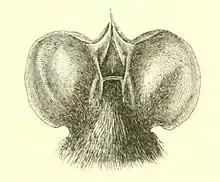| Mops atsinanana | |
|---|---|
| Scientific classification | |
| Domain: | Eukaryota |
| Kingdom: | Animalia |
| Phylum: | Chordata |
| Class: | Mammalia |
| Order: | Chiroptera |
| Family: | Molossidae |
| Genus: | Mops |
| Species: | M. atsinanana |
| Binomial name | |
| Mops atsinanana Goodman, Buccas, Naidoo, Ratrimomanarivo, Taylor and Lamb, 2010 | |
Mops atsinanana is a free-tailed bat found on Madagascar. It was considered a subspecies of the little free-tailed bat until 2010.[2] During the day, they are known to roost in man-made structures such as the roofs or attics of buildings.
Taxonomy and etymology
It was described as a new species in 2010 as the result of a taxonomic split of the little free-tailed bat, Chaerephon pumilus. With the taxonomic revision, all "C. pumilus" on Madagascar were reclassified as C. atsinanana, meaning that C. pumilus range no longer includes Madagascar. The species name "atsinanana" is derived from the Malagasy word meaning "from the east."[3]
Description

It is considered a relatively small member of the free-tailed bat family. Its forearm length ranges from 37–42 mm (1.5–1.7 in) long. Its ears are united by a connecting process referred to as the interaural membrane. It can be distinguished from the similar little free-tailed bat by its broader antitragus and tragus (ear). Its dorsal fur is blackish-brown, with a brown throat and dark-brown ventral fur. Some individuals have a small patch of white fur mid-venter, though this is uncommon. Its flight membranes are dark in color.[3]
Biology
It is nocturnal, roosting in sheltered places during the day. As of 2010, all known roosts were in manmade structures such as schools, churches, and houses. It is possible that its population has increased with urbanization due to the abundance of artificial roosting sites.[3] Natural roost sites for this species possibly include caves and rock crevices, though this is not yet confirmed.[1]
Range and habitat
It is found in several sites throughout eastern Madagascar, from 0–1,100 m (0–3,609 ft) above sea level.[3]
Conservation
It is currently evaluated as least concern by the IUCN—its lowest conservation priority.[1] This species is possibly harvested for bushmeat.[3]
References
- 1 2 3 Goodman, S. (2017). "Chaerephon atsinanana". IUCN Red List of Threatened Species. 2017: e.T67360705A67360707. doi:10.2305/IUCN.UK.2017-2.RLTS.T67360705A67360707.en. Retrieved 19 November 2021.
- ↑ Napier, M. C. (2013). Genetic Variability of Chaerephon Atsinanana (Chiroptera) Within the Context of the Afro-Malagasy Molossidae: A Mitochondrial and Nuclear Perspective (Doctoral dissertation, University of KwaZulu-Natal, Westville).
- 1 2 3 4 5 Goodman, S. M; Buccas, W; Naidoo, T; Ratrimomanarivo, F; Taylor, P. J; Lamb, J (2010). "Patterns of morphological and genetic variation in western Indian Ocean members of the Chaerephon 'pumilus' complex (Chiroptera: Molossidae), with the description of a new species from Madagascar". Zootaxa. 2551: 1. doi:10.11646/zootaxa.2551.1.1.
